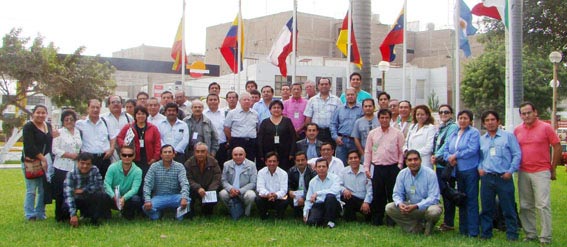The National Agricultural Innovation Institute, through the Vista Florida Experiment Station in Chiclayo, Peru, in collaboration with CIMMYT, organized the workshop “Phenotyping in plant breeding and precision agriculture” during 27-29 August 2012. The objective was to demonstrate and discuss innovative agricultural technologies and platforms that can contribute to making agriculture more modern and profitable.
Attending the workshop were 76 representatives from national institutions such as INIA, Peru’s agrarian universities, seed companies and agribusinesses, regional organizations, the International Potato Center (CIP) and FAO. The workshop consisted of lectures and field practices on the use of tools such as GPS, SPAD, and GreenSeeker. One of its strengths was the high level of interaction between instructors and participants, and the feedback given by farmers and seed company staff.
Course instructors were José Luis Araus of the Plant Biology Department of the University of Barcelona, Spain; Llorenc Cabrera-Bosquet of the Plant Ecophysiology Laboratory for Environmental Stress, Montpellier, France; Argemiro Moreno Berrocal of the Plant Breeding Department, National Coffee Research Center, Colombia, and Luis Narro from CIMMYT’s regional office in Colombia.
During the workshop, instructors stressed the importance of technologies and tools that support precision agriculture, such as remote sensing and geographic information systems (GIS). They also emphasized land-based and hand-held sensors such as SPAD-502 and GreenSeekerTM, which, among other things, can be used to improve nitrogen use efficiency in maize.
Course instructors indicated the usefulness of GIS not only for storing, organizing, and analyzing spatial data, but also for relating and geo-referencing information from different sources in support of decision making. They also showed that GPS can be used to layout plots, determine distances, and estimate plot area.
Also highlighted was the need to develop new phenotyping methodologies to improve maize tolerance to drought and other biotic stresses. A topic of discussion was the use of stable oxygen and carbon isotopes to evaluate yield potential and drought tolerance. As for phenotyping under controlled conditions, phenotyping platforms were described, particularly the PhenoArch platform located at INRA, Montpellier, France.
INIA Agricultural Research Director Enrique La Hoz and Miguel Monsalve Aita, Director of the Vista Florida Experiment Station, indicated the importance of this type of event for updating both researchers and farmers on new tools that can help make agriculture more modern and profitable. Carlos Zañartu Otoya, President of the Lambayeque Seed Producers’ Association, mentioned the Association’s intention to promote the information provided during the event and offered to help organize future workshops.

 Capacity development
Capacity development